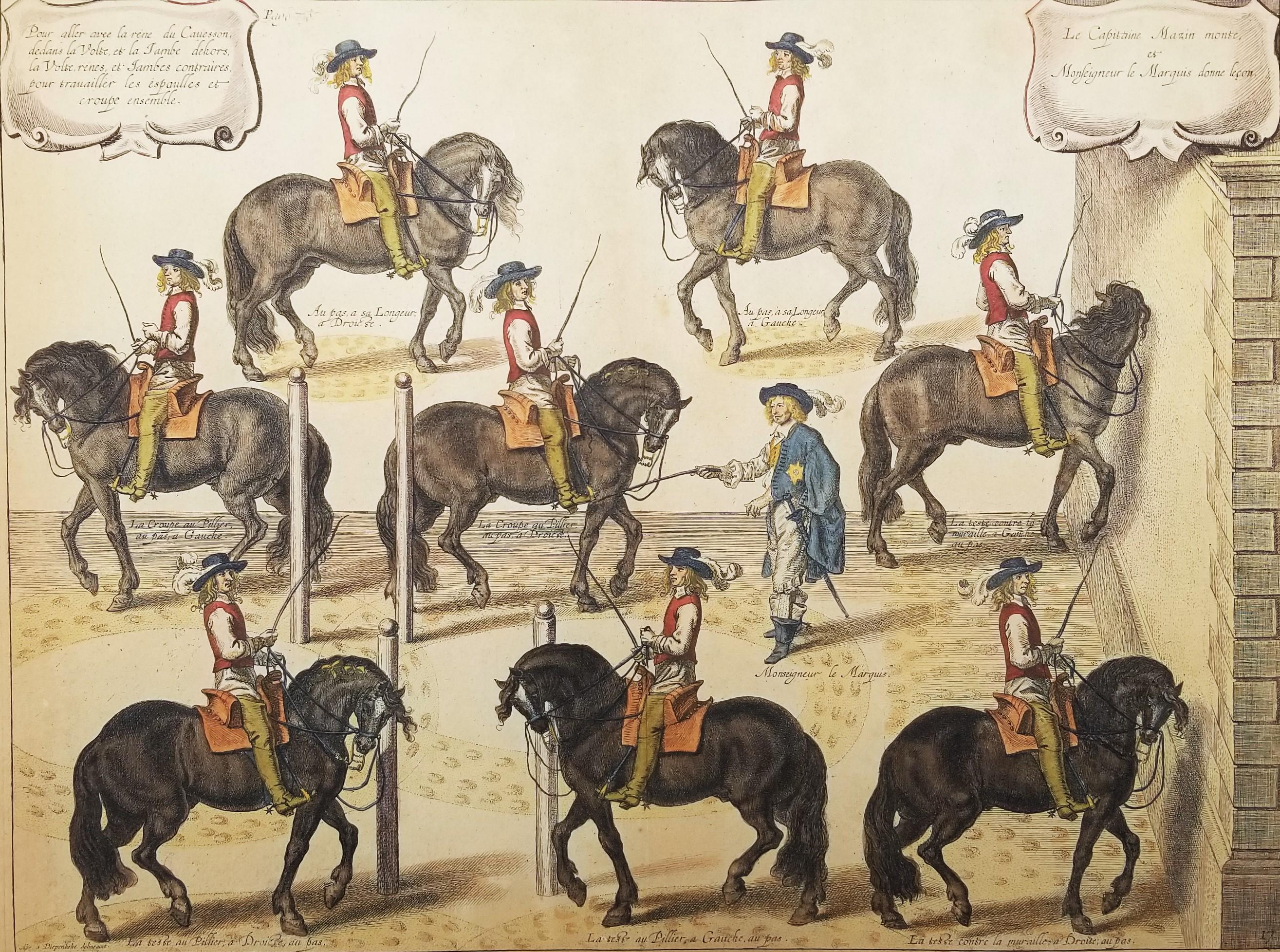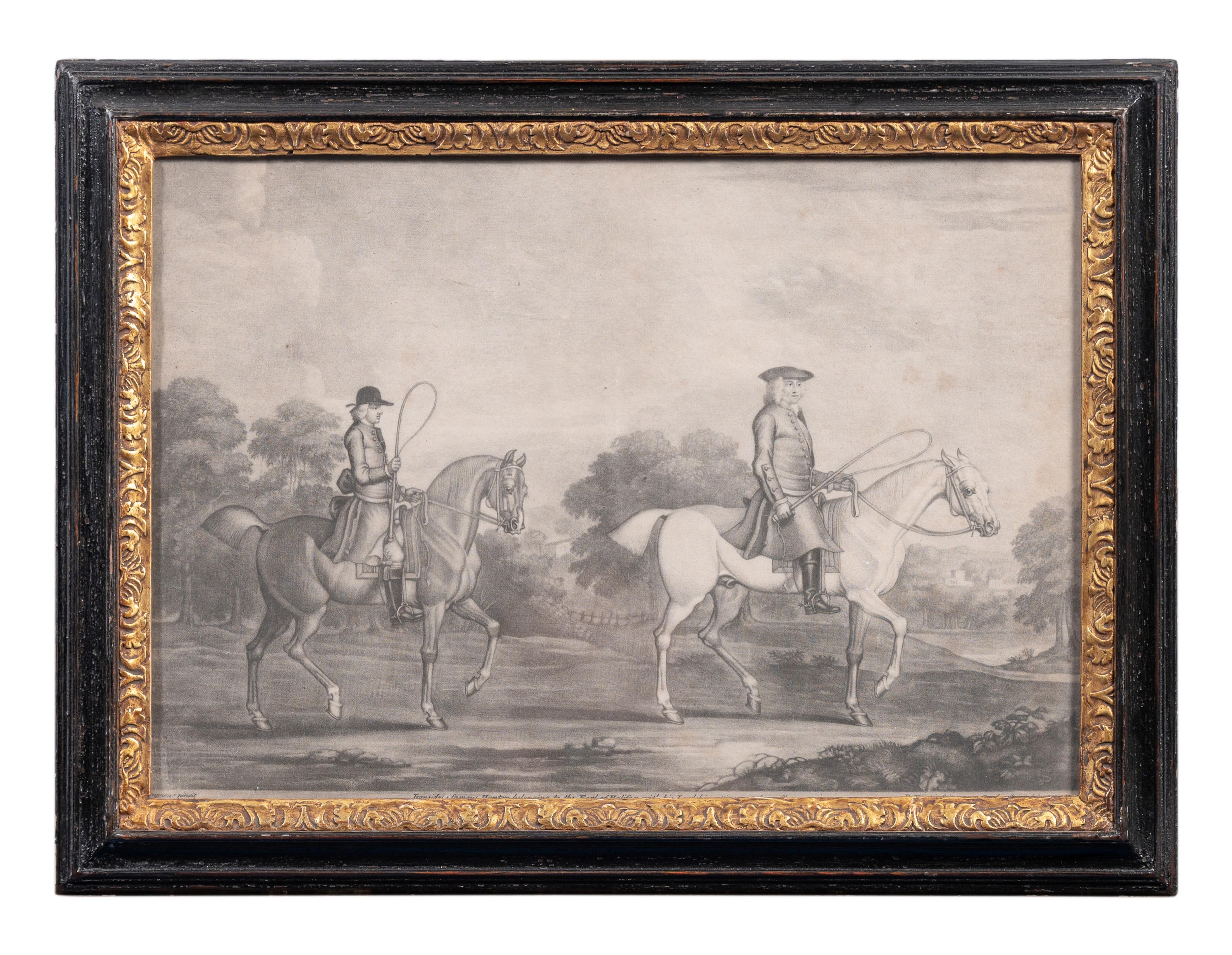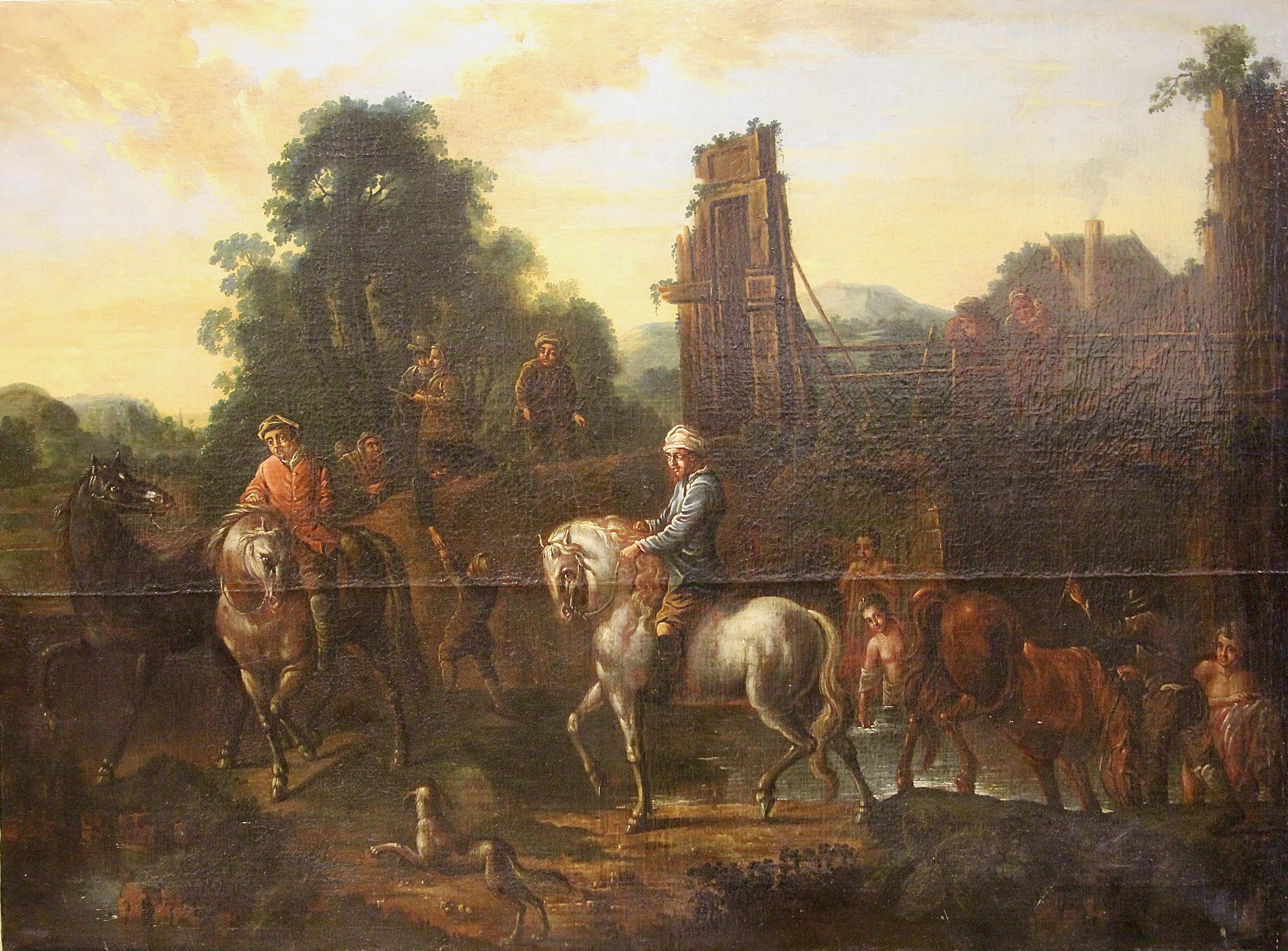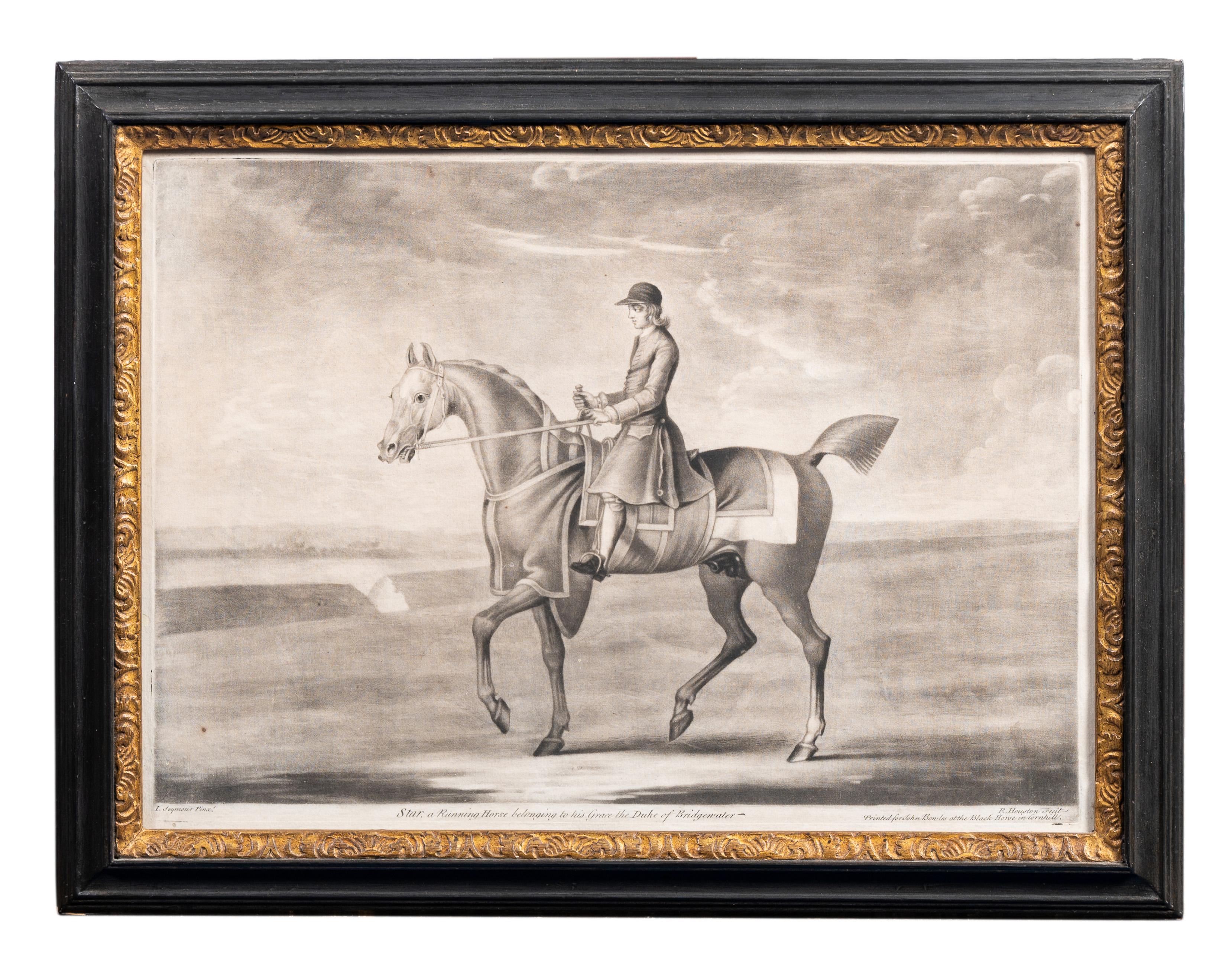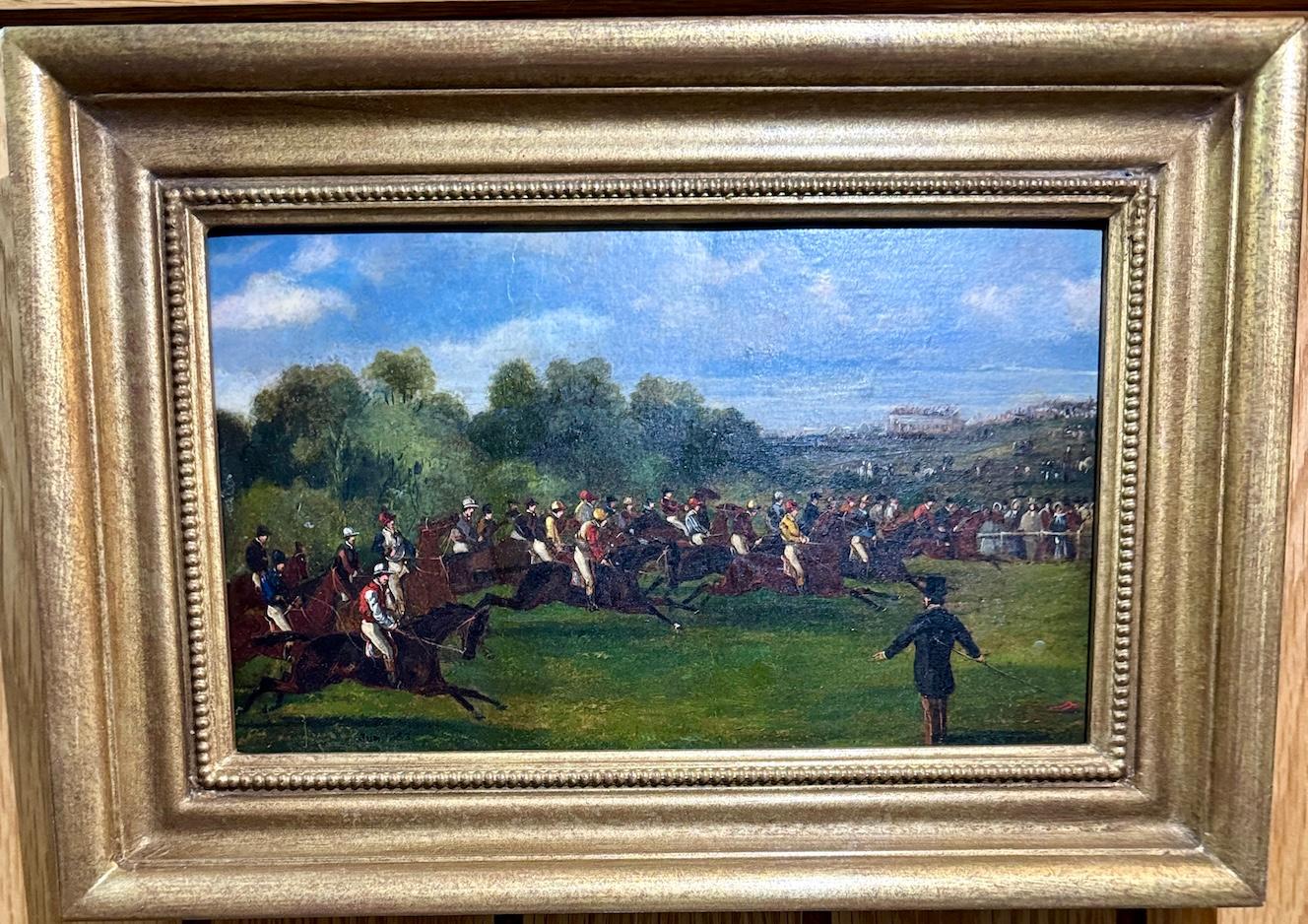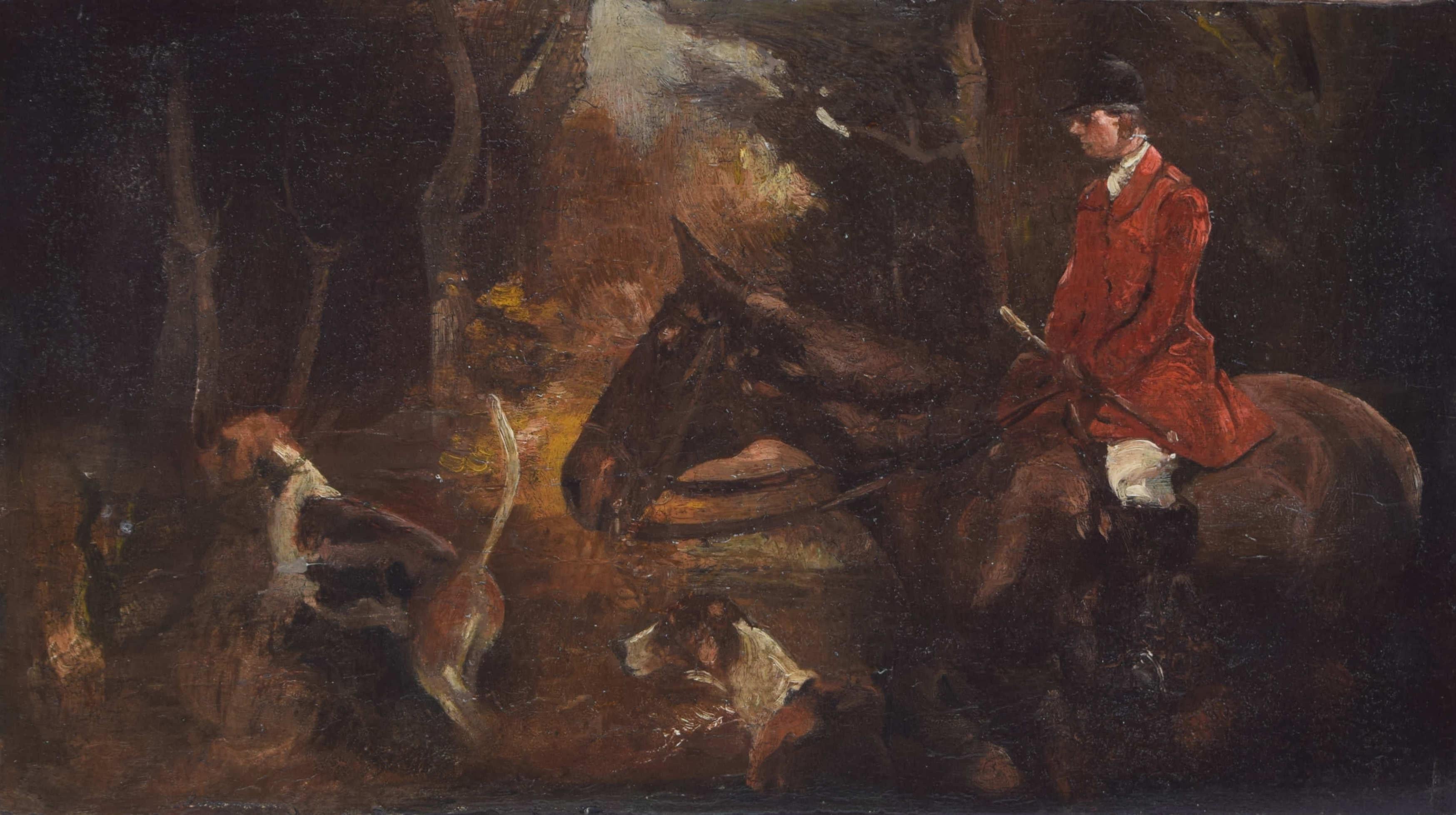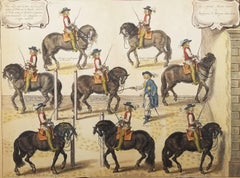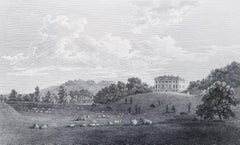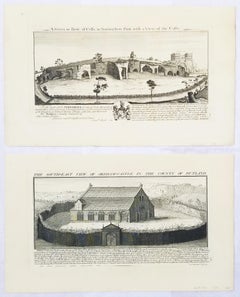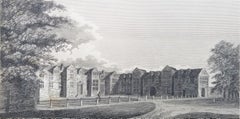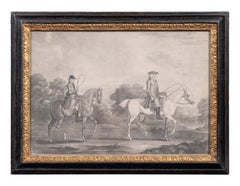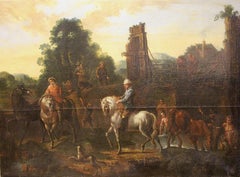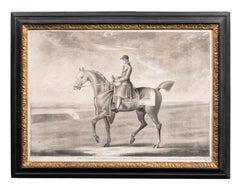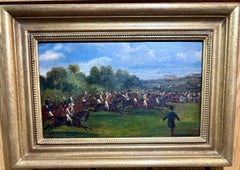Articles similaires à Welbeck Park appartient au marquis de Newcastle /// Cheval équestre vieil maître
Vous voulez plus d'images ou de vidéos ?
Demander au vendeur plus d'images ou de vidéos
1 sur 21
William CavendishWelbeck Park appartient au marquis de Newcastle /// Cheval équestre vieil maître1737
1737
1 048,72 €
À propos de cet article
Artist: William Cavendish (English, 1593-1676)
Title: "Welbeck Park Belongs to the Marquis of Newcastle" (Plate 38, Page 263)
Portfolio: Methode et Invention Nouvelle de Dresser Les Chevaux (New Method and Invention of Dressing Horses)
Year: 1737 (Second edition)
Medium: Original Hand-Colored Engraving and Etching on watermarked laid paper
Limited edition: Unknown
Printer: Jean Brindley, London, UK
Publisher: Jean Brindley, London, UK
Reference: Brunet I, 1699; Graesse II:93; Lowndes VI:1663; Mellon/Podeschi 26, page 34-35; Mennessier de la Lance II, page 246-247; Nissen ZBI 848; Huth page 21
Sheet size: 17" x 21.25"
Image size: 15" x 20"
Condition: Toning to sheet and some edgewear in right margins. Centerfold is separated at very top and bottom in margins. It is otherwise a strong impression in good condition with strong colors
Notes:
With overlapping centerfold as issued. Engraved by Dutch artist Theodor van Kessel (1620-1696) after a drawing by Dutch artist Abraham van Diepenbeeck (1596-1675). Comes from Cavendish's one volume "Methode et Invention Nouvelle de Dresser Les Chevaux", (1737) (Second edition), which consists of 42 double-paged engravings. Printed in one color from one copper plate: black. There is an unidentified fleur-de-lis style watermark in the center of the left sheet.
The 1657-1658 (First edition) of "Methode et Invention Nouvelle de Dresser Les Chevaux" was printed and published by Jacques Van Meurs in Antwerp, Belgium in two issues, 1657 and 1658. It consists of 42 double-paged copperplate engravings executed by Dutch artists Pieter de Jode II or (the Younger) (1606-1674), Pieter Clouwet (1629-1670), Pieter van Lisebetten (1630-1678), Cornelis Van Caukercken (1626-1680), Lucas Vorsterman II (1624-c.1666), Adriaen Lommelin (1620-1673), and Theodor van Kessel (1620-1696) after drawings by Dutch artist Abraham van Diepenbeeck (1596-1675). "This first printing was largely destroyed by fire in the bookseller’s shop, and is all but impossible to acquire." - Brunet. The 1737 (Second edition) of "Methode et Invention Nouvelle de Dresser Les Chevaux" was the first to be published in England using the same original 42 copperplates and 50 woodcut text diagrams from 1658, acquired by printer/publisher Jean Brindley in London, UK.
"The Duke of Newcastle, a staunch royalist went into exile to Antwerp in 1644. Newcastle had bought a pair of Barbary horses in Paris and set up a stable for training his horses. Translated from his manuscript in English, it illustrates the riding school which, in spite of the loss of a vast fortune in England during the Civil War, he managed to build up at Antwerp where he was residing as an exile from the Commonwealth. Although showered with honors by Charles II at the Restoration, he retired to his estates in Derbyshire and devoted himself to literature, the breeding of horses and equitation. His manége near Bolsover still exists. This work, partly paid for by his friend Sir Hugh Cartwright, is a celebration of Dukes' horses and their training. The plates include five equestrian portraits, four of the author; five plates of his own horses; and 24 scenes showing horses being trained (most featuring the Duke, Captain Mazin and occasionally, a groom named Palfrenier). There are also two allegorical designs, in which the Duke is adored by a circle of reverential horses, and at the end a portrait of the Cavendish family." - Christie's, New York
Biography:
William Cavendish, 1st Duke of Newcastle upon Tyne, KG, KB, PC (c. 16 December 1593 – 25 December 1676), who after 1665 styled himself as Prince William Cavendish, was an English courtier and supporter of the arts. He was a renowned horse breeder, as well as being patron of the playwright Ben Jonson and the intellectual group known as the Welbeck Circle. Despite spending the then enormous sum of £15,000 entertaining Charles I in 1634, he failed to gain a significant political post. In the early stages of the First English Civil War, he was appointed Royalist Captain-General in Northern England; he financed much of the war effort himself, later claiming this totaled in excess of £1,000,000. After the defeat at Marston Moor in July 1644, a battle fought against his advice, he went into exile in Europe. He returned to England after the Stuart Restoration in 1660, and although created Duke of Newcastle in 1665, he remained on the fringes of the court and became critical of Charles II. He died in 1676 and was buried in Westminster Abbey.
- Créateur:William Cavendish (1593 - 1676, Anglais)
- Année de création:1737
- Dimensions:Hauteur : 43,18 cm (17 po)Largeur : 53,98 cm (21,25 po)
- Support:
- Mouvement et style:
- Période:1730-1739
- État:
- Adresse de la galerie:Saint Augustine, FL
- Numéro de référence:1stDibs : LU12126068442
À propos du vendeur
5,0
Vendeur Platine
Vendeurs premium dont la note est supérieure à 4,7 et le délai de réponse de 24 heures maximum
Établi en 1978
Vendeur 1stDibs depuis 2015
1 342 ventes sur 1stDibs
Temps de réponse habituel : <1 heure
- ExpéditionRecherche du devis...Expédition depuis : Saint Augustine, FL
- Politique des retours
Certaines parties de cette page ont été traduites automatiquement. 1stDibs ne garantit pas l'exactitude des traductions. L'anglais est la langue par défaut de ce site web.
Garantie d'authenticité
Bien qu'il soit peu probable que la situation se présente, dans le cas où vous rencontreriez un problème d'authenticité d'un article, contactez-nous dans un délai d'un an pour obtenir un remboursement intégral. DétailsGarantie de remboursement
Si votre article n'est pas conforme à la description, est endommagé pendant le transport ou ne vous est pas livré, contactez-nous sous 7 jours pour obtenir un remboursement intégral. DétailsAnnulation sous 24 heures
Vous disposez d'un délai de 24 heures pour annuler votre achat sans motif.Des vendeurs professionnels agréés
Nos vendeurs de renommée mondiale doivent respecter des normes strictes en matière de service et de qualité, afin de préserver l'intégrité de nos fiches produit.Garantie d'alignement des prix
Si vous constatez qu'un autre vendeur a mis en vente le même article à un prix inférieur sur un autre site, nous nous alignerons sur ce prix.Livraison en toute confiance à l'international
Notre réseau de transporteurs de premier ordre propose des options d'expédition spécialis�ées dans le monde entier, y compris des livraisons personnalisées.Plus d'articles de ce vendeur
Tout afficherLe capitaine Mazin Rides, and the Marquis Gives the Lesson /// Art du cheval équestre
Par William Cavendish
Artistics : William Cavendish (anglais, 1593-1676)
Titre : "Le capitaine Mazin monte à cheval et le marquis donne la leçon" (planche 17, page 76)
Portfolio : Methode et Invention Nou...
Catégorie
années 1730, Maîtres anciens, Estampes - Animaux
Matériaux
Aquarelle, Papier vergé, Gravure, Eau-forte, Intaille
The, le siège de l'Hon. Lionel Damer /// Dorsetshire John Hutchins anglais
Artistics : John Hutchins (anglais, 1698-1773)
Titre : "Came, the Seat of the Hon. Lionel Damer" (planche 48)
Portfolio : L'histoire et les antiquités du comté de Dorset
Année : 1796-1815 (Deuxième édition)
Support : Gravure originale sur papier vélin
Edition limitée : Inconnu
Imprimeur : John Bowyer Nichols, Londres, Royaume-Uni
Éditeur : Richard Gough et John-Richard Nichols, Londres, Royaume-Uni
Référence : Brunet III, n° 389 ; Upcott I, n° 48, page 183
Taille de la feuille : 9.19" x 15.5"
Taille de l'image : 7.19" x 11.88"
Condit : Quelques légères rousseurs en bas à droite de l'image et dans les marges. Il a été entreposé professionnellement pendant des décennies. Il s'agit par ailleurs d'une forte impression en excellent état.
Notes :
Collectional : collection privée - Aspen, CO. Gravure de l'Anglais John Emes (1762-1810) d'après un dessin de l'Anglais John Laporte (1761-1839). Provient de l'ouvrage en quatre volumes de Hutchins "The History and Antiquities of the County of Dorset", (1796-1815) (deuxième édition), qui comprend environ 180 gravures. Imprimé à partir d'une seule plaque de cuivre en une seule couleur : noir. L'ouvrage de John Hutchins intitulé "The History and Antiquities of the County of Dorset" a été publié en 1774 (première édition) dans une édition limitée à 600 exemplaires, puis de 1796 à 1815 (deuxième édition) et enfin de 1861 à 1870 (troisième édition).
Came House est une maison de campagne privée située à proximité du village de Winterborne Came, dans le Dorset, en Angleterre. Construit au milieu du XVIIIe siècle, il est classé monument historique. La maison a été construite pour John Damer par Francis Cartwright de Blandford en 1754 ; après la mort de Cartwright en 1758, l'intérieur a été complété par Vile et Cobb, ébénistes de Londres, en 1762. Il y a une aile de cuisine à l'est, reliée à la maison par un passage. Au milieu du XIXe siècle, une entrée avec porche, vestibule et vestiaires, ainsi qu'un jardin d'hiver à coupole en fonte, ont été ajoutés sur le côté ouest de la maison. Le jardin d'hiver est attribué à l'architecte Charles Fowler. Une bibliothèque a également été créée à cette époque et d'autres changements mineurs ont été apportés. Pour le reste, il y a eu peu de modifications.
Biographie :
John Hutchins (1698-1773) était un ecclésiastique de l'Église d'Angleterre et un topographe anglais, qui est surtout connu comme historien du comté de Dorset. John Hutchins est né à Bradford Peverell, Dorset, le 21 septembre 1698. Il était le fils de Richard Hutchins (mort en 1734), qui fut pendant de nombreuses années vicaire dans cette ville et, à partir de 1693, recteur de l'église All Saints, à Dorchester. Sa mère, Anne, est décédée le 9 avril 1707 et a été enterrée dans l'église de Bradford Peverell. Il a fait ses premières études sous la direction du Rév. William Thornton, maître de la Dorchester Grammar School, et le 30 mai 1718, il s'inscrit à Hart Hall...
Catégorie
années 1790, Maîtres anciens, Estampes - Paysage
Matériaux
Gravure
"Oakham Castle" et "Nottingham Park/Castle" de "Buck's Antiquities" /// Royaume-Uni
Par Samuel & Nathaniel Buck
Artistics : Samuel et Nathaniel Buck (anglais, 1696-1779) et (?-1759/1774)
Titre : "Oakham Castle" (planche 242) et "Nottingham Park/Castle" (planche 226)
Portfolio : Buck's Antiquit...
Catégorie
années 1720, Maîtres anciens, Estampes - Paysage
Matériaux
Papier vergé, Gravure, Intaille
Loseley House, The Seat of James More Molyneux Esq. /// Paysage anglais du Surrey
Artistics : Owen Manning (anglais, 1721-1801)
Titre : "Loseley House, The Seat of James More Molyneux Esq." (Maison de Loseley, siège de James More Molyneux Esq.)
Portefeuille : L'hi...
Catégorie
Début des années 1800, Victorien, Estampes - Paysage
Matériaux
Gravure
Het leeuwendeel (La part du lion) /// Old Masters Animals Landscape Dog Leopard
Par Dirk Stoop
Artistics : Dirk Stoop (hollandais, c.1615-1686).
Titre : "Het leeuwendeel (The Lion's Share)" (La part du lion)
Portfolio : Les fables d'Esope
Année : 1665 (un état antérieur à des ...
Catégorie
années 1660, Maîtres anciens, Estampes - Animaux
Matériaux
Eau-forte, Papier vergé, Intaille, Gesso
Ensemble de deux gravures de l'ouvrage de Nash intitulé « History of Worcestershire » /// Landscapes Art
Par Treadway Russell Nash
Artistics : Treadway Russell Nash (anglais, 1724-1811)
Titre : "Henbury Hall, ancien siège de Thomas Vernon, aujourd'hui de Henry Cecil Esq." et "Ombersley Court, siège de Lord Sandy...
Catégorie
années 1780, Maîtres anciens, Estampes - Paysage
Matériaux
Papier vergé, Gravure, Intaille, Eau-forte, Aquatinte
Suggestions
Ironsides", un célèbre chasseur appartenant au comte de Halifax.
Par James Seymour
James Seymour (1702-1752)
Ironsides", un célèbre chasseur appartenant au comte de Halifax.
Mezzotint de R. Houston
Taille de l'image 9 1/4 x 13 1/4 in
Encadré 12 x 16 in
James Seymo...
Catégorie
XVIIIe siècle, Maîtres anciens, Peintures - Animaux
Matériaux
Manière noire
17e siècle, peinture de maîtres anciens, huile sur toile, « Le reste avec les chevaux »
XVIIe siècle, peinture de maître ancienne, huile sur toile, "Le reste avec les chevaux".
Toile regarnie.
La civière a également été renouvelée une fois.
La peinture est plutôt somb...
Catégorie
XVIIe siècle, Maîtres anciens, Peintures - Figuratif
Matériaux
Toile, Huile
14 400 € Prix de vente
50 % de remise
Livraison gratuite
Star", un cheval de course appartenant à Sa Grâce le Duc de Bridgewater.
Par James Seymour
James Seymour (1702-1752)
Star", un cheval de course appartenant à Sa Grâce le Duc de Bridgewater.
Mezzotint de R. Houston
Taille de l'image 10 x 14 pouces
Encadré 13 x 17 in
James ...
Catégorie
XVIIIe siècle, Maîtres anciens, Peintures - Animaux
Matériaux
Manière noire
Paysage anglais du 19e siècle avec Courses de chevaux, éventuellement le Derby d'Epsom
Par Samuel Henry Alken
Samuel Henry Alken (1810–1894)
Horse Racing Scene, Possibly the Epsom Derby
Oil on board, unsigned
Attributed, English school circa 1840
Presented in a later gilt frame with beaded i...
Catégorie
années 1840, Victorien, Peintures - Figuratif
Matériaux
Huile, Planche
5 619 €
Livraison gratuite
Foxhunting oil painting attributed to Thomas Ivester Lloyd
Par Thomas Ivester Lloyd
John Ivester Lloyd (1873 - 1942)
Chasse au renard
Huile sur carton
20 x 36 cm
Un chasseur et des chiens de chasse traversent un bois sombre.
Thomas Ivester Lloyd (1873 - 1942) est ...
Catégorie
Début du XXe siècle, Peintures - Animaux
Matériaux
Huile, Planche
Le "Copenhagen" du duc de Wellington, monté lors de la bataille de Waterloo.
Par William Webb
William Webb (1780-1846)
Le "Copenhagen" du duc de Wellington, monté à Waterloo, le "Bitter" de Sir John Whiting, la jument alezane du duc de Wellington, le cheval arabe blanc du duc...
Catégorie
XIXe siècle, Victorien, Peintures - Animaux
Matériaux
Huile
